Ancient Egypt is recognized for its diverse array of symbols. Symbols signify something beyond their literal depiction, and in ancient Egypt, that profound significance was always connected to the essence of existence itself.
Ancient Egyptian symbols, depicted as hieroglyphs called the “Words of the Gods,” played a crucial role in their spiritual and cultural existence and were essential for documenting significant events and beliefs.
Intriguing and intricate ancient Egyptian symbols, or hieroglyphs, consist of a combination of ideograms (symbols denoting ideas), phonograms (symbols indicating sounds), and determinatives (symbols enhancing meaning).
Every symbol had significance in the lives of the ancient Egyptians. It was frequently associated with life, death, birth, rebirth, strength, love, safety, healing, vulnerability, hatred, and beyond.
In ancient Egyptian society, where the distinction between the earthly realm and the divine realm was vague, symbols functioned as links that united individuals with the deities and the entire cosmos. They were employed to adorn everything from temple walls, obelisks, statues, and amulets to burial goods and daily objects, adding a magical element to the mundane.
Ancient Egyptian symbols can possess various meanings depending on the context; for our purposes, The thirty symbols below collectively encapsulate the spiritual, political, and cultural ethos of ancient Egypt, reflecting their profound connection to cosmology, divinity, and the afterlife.
List of the famous Ancient Egyptian Symbols
1-Ankh
The Ankh, resembling a cross with a looped top, is one of the most iconic symbols of ancient Egypt. 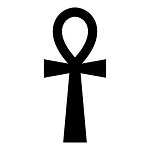
2- Eye of Horus (Wadjet)
The Eye of Horus, is a stylized human eye with markings resembling a falcon’s eye, reflecting Horus’s divine association. 
3- Scarab (Khepri)
The scarab beetle, associated with the god Khepri, represented rebirth and the sun’s daily journey. 
4- Djed Pillar
The Djed Pillar, a column-like symbol with horizontal bands, embodied stability and endurance. 
5- Was Scepter
The Was Scepter, a staff topped with a stylized animal head (often a Set-animal or jackal), symbolized dominion over chaos and divine authority. 
6- Uraeus
The Uraeus, a rearing cobra, adorned the crowns of pharaohs and gods as a symbol of sovereignty and protection. 
7- Ba
The Ba, depicted as a human-headed bird, symbolized the soul’s mobility after death. 
8- Ka
The Ka, represented by a pair of upraised arms, was the spiritual double or life force of a person.
9- Shen Ring
The Shen Ring, a loop of rope tied at the bottom, symbolized infinity and eternal protection.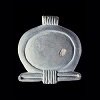
10- Feather of Maat
The Feather of Ma’at, an ostrich plume, embodied truth, justice, and cosmic order.
11- Crook and Flail
The crook (shepherd’s staff) and flail (threshing tool) symbolized the pharaoh’s role as provider and enforcer.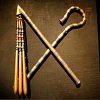
12- Lotus (Sesen) and Papyrus
The lotus (water lily) and papyrus plants symbolized the union of Upper and Lower Egypt.
13- Bennu Bird
The Bennu, a heron-like bird, was the Egyptian phoenix and an emblem of Ra’s soul.
14- Tyet (Isis Knot)
The Tyet, resembling an ankh with arms folded downward, symbolized protection through the blood of Isis.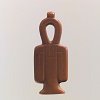
15- Cartouche
A cartouche is an oval enclosing the hieroglyphs of a royal name, encircled by a rope to denote the pharaoh’s dominion over the cosmos. 
16- Seba Star
The Seba, a five-pointed star hieroglyph, symbolized the stars and constellations guiding souls through the Duat (underworld).
17- Menat Necklace
The Menat, a heavy beaded necklace with a counterpoise, was sacred to Hathor, the goddess of joy and fertility.
18- Atef Crown
The Atef Crown, a white hedjet crown flanked by ostrich feathers and ram’s horns, symbolized Osiris’s resurrection and divine authority.
19- Nemes Headdress
The Nemes, a striped cloth headdress with lappets draping over the shoulders, signified the pharaoh’s divine status.
20- Deshret (Red Crown)
The Deshret, a red crown with a coiled wire and tall back, symbolized rule over Lower Egypt (the Nile Delta).
21- Hedjet (White Crown)
The Hedjet, a tall white conical crown, represented sovereignty over Upper Egypt.
22- Pschent (Double Crown)
The Pschent combined the Deshret (Red Crown) and Hedjet (White Crown), symbolizing the pharaoh’s rule over a unified Egypt.
23- Khepresh Crown
The Khepresh, known as the Blue Crown or the War Crown, was a royal headdress in ancient Egypt.
24- Sistrum
The sistrum, a musical rattle with Hathor’s head atop a looped frame, produced sounds believed to appease gods and repel chaos.
25- Winged Sun Disk
The winged sun disk, featuring a solar disc flanked by outstretched falcon wings, represented divine kingship and solar power.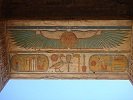
26- Serekh
The Serekh, a rectangular palace façade topped by a Horus falcon, enclosed early pharaohs’ names, symbolizing their dual role as earthly rulers and incarnations of Horus.
27- Reed and Bee
The Reed or Su Plant and the Bee are magical symbols that represent the union of Upper and Lower Egypt “The Two Lands”.
28- Tree of Life
The sycamore or acacia tree, known as the Egyptian Tree of Life held great significance for the ancient Egyptians, symbolizing water, abundance, and fertility.
29- Ouroboros
The Ouroboros, a serpent devouring its tail, symbolized cyclical time and eternal renewal.
30- Rekhyt Bird
The Rekhyt-bird was a symbol of the common people in ancient Egypt. 
Conclusion: Ancient Egyptian Symbols
The world of Ancient Egyptian symbols is a fascinating window into one of history’s most mysterious civilizations. Each hieroglyph, amulet, and sacred image carried deep meanings, connecting the people to their gods, afterlife, and daily life. From the Ankh, symbolizing eternal life, to the Eye of Horus, representing protection and healing, these symbols were more than art—they were expressions of faith and cosmic order.
Even today, these timeless icons continue to inspire modern design, jewelry, and spirituality. They remind us of Egypt’s enduring wisdom and its people’s belief in the power of symbols to shape destiny. Exploring them is like decoding the spiritual heartbeat of ancient Egypt itself—beautiful, powerful, and eternal.

